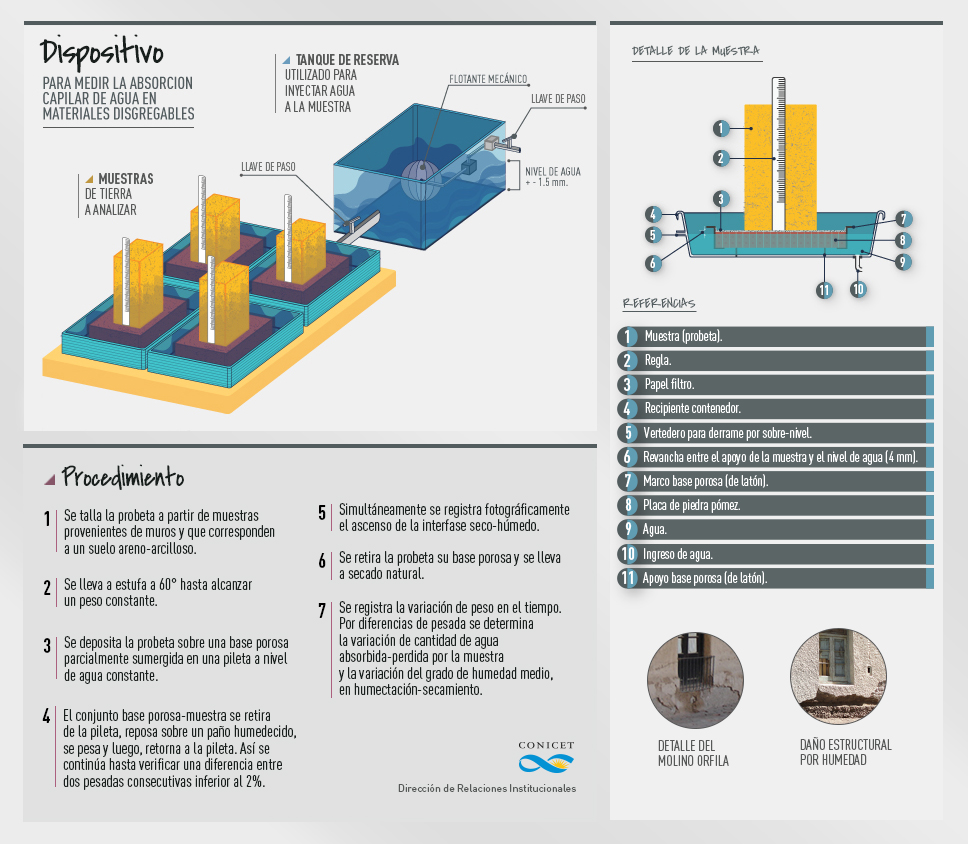TECHNOLOGY TRANSFER OFFICE
Science to reconstruct urban memory
CONICET researchers develop a method that enables the preservation of monuments in Cuyo
The metropolitan area of the city of Mendoza has 1.200 historical buildings of great heritage value. One third of them are partially or wholly made up of adobe, rammed earth or quincha (a cane or bamboo weave covered with clay). A survey conducted by CONICET researchers detected that 96% of these buildings are affected by rising damp from the substructure. In order to preserve and improve their restoration, researchers developed a device and a method to measure capillary absorption in materials commonly used in traditional, historical and ecological buildings.
Silvia Cirvini, CONICET principal researcher at the Instituto de Ciencias Humanas, Sociales y Ambientales (INCIHUSA-CONICET) explains that the dampness caused by capillary ascension is a recurrent problem that is exacerbated by seismic activity in the region, what weakens the walls and increases the risk of collapse of the constructions.
Cirvini’s team developed two products: a device and a test procedure. The former is basically a system to measure capillary absorption in graduated cylinders of disaggregated material -soil- in the presence of water. The trial consisted of placing the graduated cylinders on pumice – a porous igneous rock- partially submerged in clean water at constant level. Then, at regular intervals the researchers assessed the weight increase in the graduated cylinder and the reduction of water in the tank.
“The procedure involves recording successive measurements of the increase in dampness. Since graduated cylinders are made of soil, when they are in contact with dampness, they change the colour from light dun to dark, which is easy to distinguish. A sequence shot of this enables to determine with simple arithmetical calculations, the capillary rise velocity, the variation of absorbed water and drained-evaporated water, the dampness content and drying rate”, explains José Gómez Voltán, CONICET main professional at the INCIHUSA and responsible for the experimental and technical area of development.
This device was designed for materials that crumble when in contact with water. It is an important contribution regarding other similar technologies that can only determine superficial absorption of water on the material instead of the process of capillary ascension. Likewise, the simplicity, quickness, and low cost of the procedure enable its dissemination in countries where these building materials are available.
“In old buildings some studies such as breaking a wall to examine its state cannot be done. The examination to assess the dampness has to be conducted through tests with small samples and using a method that does not worsen its situation. This development is easy to replicate and can be applied to unfired clay monuments, very common in the Argentine northwest region and Bolivia. It can be produced in any simple laboratory of Latin America, thus allowing people to determine the humidity and the severity of the condition of the wall, how humidity rises and how the wall responds”, Cirvini adds.
For his part, Gómez Voltán explains that building a structure using rammed earth is very pragmatic and has little science behind it. For this reason, this tool is economical, easy to access and operate, and it is a valid proposal to establish a standard of building. Therefore, it would be possible to establish maximum values of capillary ascension velocity above which it would not be recommended to build structures using this type of material or technique.
This device and the method to measure capillary absorption of water in disaggregated material enable to determine vulnerability degrees, and morphological and architectural deterioration to enhance building systems for the structural restoration of heritage buildings without risking them. Furthermore, it is useful to optimize the new adobe or rammed earth constructions because it allows us to prevent problems, determine the state of damp-deterioration and assess the mechanical capacity of a rammed earth wall to improve the mixture of materials when building.
“Adobe buildings demand constant maintenance and the population that inhabits those constructions does not have the financial capacity to afford those costs. This could lead to a complete or partial breakdown in times of heavy rain because the walls have a permanent humidity level and the extra increment provided by the storm is enough to reduce their carrying capacity to cero”, the engineer comments.
- By Cecilia Leone
